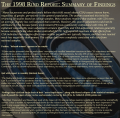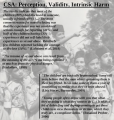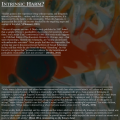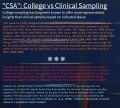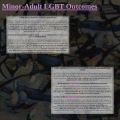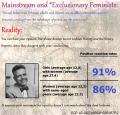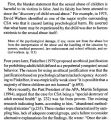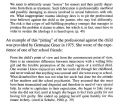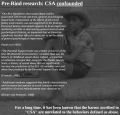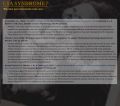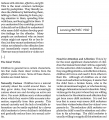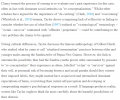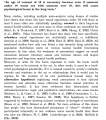One of our staff members is contributing considerably to a News Archiving service at Mu. Any well educated (Masters, PhD or above) users who wish to make comments on news sites, please contact Jim Burton directly rather than using this list, and we can work on maximising view count.
Research: Secondary Harm
Secondary harm may occur when a childhood sexual experience is reinterpreted as abusive, or when police or parents intervene in an intergenerational relationship. Moral incongruence (even absent legal intervention) is already a well-established cause of harm in taboo sexual practises.[1]
Evidence that secondary harm occurs
Stigma as a factor
- Bauserman, Robert; Rind, Bruce (1997). "Psychological Correlates of Male Child and Adolescent Sexual Experiences with Adults: A Review of the Nonclinical Literature," Archives of Sexual Behavior, 26(2), 105-141.
- "Secondary consequences include reactions of others, such as parents and peers, to the sexual contacts. Feelings of guilt and shame regarding the sexual contacts, which are based on perceived violation of one’s own and others’ norms, are also addressed here.
- Emotional responses of guilt were related to outcomes, with greater guilt associated with more negative responses, Haugaard and Emery (1989) and Okami (1991) both reported guilt feelings to be associated with negative evaluations of experiences. Stein et al. (1988), in their study of unwanted experience in a community sample, noted that feelings of guilt and shame were common. Risin and Koss (1987) reported that guilt feelings were more common in experiences involving fondling, which were also associated with more force and greater levels of other negative feelings. Finally, Sandfort (1984) reported that when the boys interviewed in his study were asked about negative aspects of their relationships, many cited concerns about possible negative reactions from others, such as parents, peers, and authorities.
- The role of socialization in these reactions may be very important. Finkelhor (1979) and Fritz et al. (1981) both suggested that boys’ reactions may be more positive than those of girls because boys are socialized to regard sex in a more positive fashion, whereas girls receive more negative messages. Fritz et at. (1981) stated that although girls typically regarded their experiences as sexual violation, boys often regarded their experiences as sexual initiation.
- Clearly, feelings of guilt and shame and concerns about negative reactions from others are associated with negative responses to early sexual contacts with adults. These responses, however, are not inherent in the sexual contact per se but rather stem from social taboos and condemnation (cf. Constantine, 1981). To the extent that boys receive more positive messages regarding sexuality, they are less likely to experience these negative emotions and to react negatively to sexual contacts."
 | ||||||||||||
| Part of NewgonWiki's research project | ||||||||||||
|---|---|---|---|---|---|---|---|---|---|---|---|---|
|
| ||||||||||||
| ||||||||||||
|
| ||||||||||||
| Template: Research - This template |
- Nelson, Joan A. (1986). "Incest: Self-Report Findings From a Nonclinical Sample," Journal of Sex Research, 22(4), 473-474.
- "No force of any kind was found in 49% (68) of the reports. Yet 30% (14) of these no-force experiences were described as negative. The individuals described their otherwise consensual experiences as affected negatively by guilt or fear of social or parental disapproval, an issue which emerged repeatedly in the interviews and written responses, both positive and negative. Approximately half of the female respondents and 4% of the male respondents stated that they continued to experience conflict in regard to their incest experiences, usually associated with, if not a direct result of, guilt, even though many of the relationships had terminated many years before the report. One respondent commented, "I went crazy trying to understand how anything so good could be so bad.""
- Higgins, D. J., & McCabe, M. P. (2003). "Maltreatment and Family Dysfunction in Childhood and the Subsequent Adjustment of Children and Adults," Journal of Family Violence, 18(2)
- Three co-published studies. In Study 1, "Parental sexual punitiveness, traditionality, family adaptability and family cohesion significantly predicted scores on 4 maltreatment scales and children's externalizing behavior problems." In Study 2, "Parental sexual punitiveness, traditionality, family adaptability, and family cohesion during childhood predicted the level of maltreatment and current psychopathology."
- Coffey, P., Leitenberg, H., Henning, K., Turner, T., & Bennett, R. T. (1996). "Mediators of the long-term impact of child sexual abuse: Perceived stigma, betrayal, powerlessness, and self-blame," Child Abuse & Neglect, 20(5), pp.447-455
- "Regression analyses entering only the level of sexual activity to predict the mediator variables found that level of sexual activity was related to stigma [...] The level of sexual activity was also a direct predictor o1 the GSI when entered into a regression as the sole predictor [...] However, when level of sexual activity and the mediator variables were used in combination to predict GSI, this analysis yielded an X2 of .33, F(5,168) = 16.71, p < .0000 and the only predictors that accounted for unique variance in the GSI were two of the mediators. They were stigma (B = .36), F = 17.04, p < .001 and self-blame (B = .25), F = 11.99, p < .0007. The level of sexual activity was no longer a significant predictor of the GSI score when the mediators were entered into the equation. The results of this path analysis therefore indicate that the only mediational paths in predicting adjustment on the GSI were for level of sexual activity via stigma and self-blame. [...] Because the path analysis tests a particular mediation model it is also fair to say that these results support the hypothesis that stigma and self-blame may underlie the long-term negative impact of a child sexual abuse experience. [...] Clearly feelings of self-blame and stigma regarding child sexual abuse can linger long into adulthood. This sense of feeling ashamed, tainted, and blameworthy regarding the abuse may impact adjustment by affecting the survivor's core beliefs about their worth as a person. Struggling with these feelings may result in heightened levels of psychological distress. These findings further suggest that feelings of both stigma and serf-blame in adulthood are particularly affected by the level of sexual activity involved in the abusive experience. It may be that higher levels of sexual activity result in an increased sense of being "damaged goods" and tainted due to a greater sense of personal and societal violation. Certainly society considers intercourse to be the most taboo form of sexual contact with children."
- Finkelhor, D. & Browne, A. (1985). "The traumatic impact of child sexual abuse: A conceptualization," American Journal of Orthopsychiatry, 55 (4), 530-541.
- Three of the four "tramagenic dynamics" proposed by Finkelhor for child sexual abuse are related to Western society's conceptualization of sex or reaction to CSA. "Betrayal refers to the dynamic by which children discover that someone on whom they were vitally dependent has caused them harm. This may occur in a variety of ways in a molestation experience. For example, in the course of abuse or its aftermath, children may come to the realization that a trusted person has manipulated them through lies or misrepresentations about moral standards. They may also come to realize that someone whom they loved or whose affection was important to them treated them with callous disregard. [...] A child who was suspicious of a father’s activities from the beginning may feel less betrayed than one who initially experienced the contact as nurturing and loving and then is suddenly shocked to realize what is really happening. Obviously, the degree of betrayal is also related to a family’s response to disclosure. Children who are disbelieved, blamed, or ostracized undoubtedly experience a greater sense of betrayal than those who are supported. [...] Powerlessness – or what might also be called disempowerment, the dynamic of rendering the victim powerless – refers to the process in which the child’s will, desires, and sense of efficacy are continually contravened. [...] But force and threat are not necessary; any kind of situation in which a child feels trapped, if only by the realization of the consequences of disclosure, can create a sense of powerlessness. [...] Stigmatization, the final dynamic, refers to the negative connotations (e.g., badness, shame, and guilt) that are communicated to the child around the experiences and that then become incorporated into the child’s self-image. These negative meanings are communicated in many ways. They can come directly from the abuser, who may blame the victim for the activity, demean the victim, or furtively convey a sense of shame about the behavior. Pressure for secrecy from the offender can also convey powerful messages of shame and guilt. But stigmatization is also reinforced by attitudes that the victim infers or hears from other persons in the family or community. Stigmatization may thus grow out of the child’s prior knowledge or sense that the activity is considered deviant and taboo, and it is certainly reinforced if, after disclosure, people react with shock or hysteria, or blame the child for what has transpired. Children may be additionally stigmatized by people in their environment who now impute other negative characteristics to the victim (e.g., loose morals or “spoiled goods”) as a result of the molestation. [...] Some children may be too young to have much awareness of social attitudes and thus experience little stigmatization, whereas others have to deal with powerful religious and cultural taboos in addition to the usual stigma." The single non-related dynamic ("traumatic sexualization") explains responses that are considered negative because of Western society's conceptualization of sex.
- Malón, Agustín (2009). "Onanism and Child Sexual Abuse: A Comparative Study of Two Hypotheses", Archives of Sexual Behavior
- This article agrees with the above analysis of Finkelhor's model: "Finkelhor and Browne (1985) hypothesized four “traumatogenic dynamics”: traumatic sexualization, deceit, defenselessness, and stigmatization, and claimed these explained the traumatic specificity of CSA, something that is different from other otherwise equally severe trauma. But even a cursory examination of these shows they are found in other than CSA experiences, all are not always present, nor are they necessarily intrinsic to the child’s experience; they are, in fact, largely extrinsic societal artifacts."
- Anne-Marie Grondin (2011). ‘Thinking outside specious boxes: constructionist and post-structuralist readings of ‘child sexual abuse’, in Sex Education, 11:3, 243-254.
- "[S]ome children undergoing sexual abuse victimization therapy interpret their experience as neither abusive nor harmful (Angelides 2004, 160). For children declared child sexual abuse (CSA) ‘victims’, however, therapy can be mandatory, even if they deny having been molested (Gallo-Lopez 2000, 273) [...] the first task for therapists is to lead children to recast their denials of injury as accounts of abuse and of victimization (Davis 2005, 167). In other words, therapists encourage children to rewrite their experiences to fit the parameters of the dominant CSA framework, wherein victims and offenders are conceptualized in absolutes" (pp. 223-224).
- "Accordingly, children in therapy are automatically ascribed the status of victim, heedless of their accounts of what transpired. Once they acknowledge both abuse and victimhood, children are prompted to recognize their innocence (Celano et al. 2002) [...] Children who feel that the dominant framework does not reflect their interpretations are nevertheless expected to adopt it. Indeed, children’s espousal of the dominant framework and concomitant denial of alternative narratives are seen as markers of therapeutic success. [...] When children recognize their experience as abuse a priori, it certainly makes sense to lessen feelings of blame or responsibility. In the absence of these feelings, however, this strategy’s usefulness becomes paradoxical. More precisely, it aims to produce in children a sense of having been harmed in order to mitigate this same sense of harm [...] impos[ing] a meaning that [...] directly contradicts the child’s own perception [...] reinforces the idea that they lack power and control" (p. 224).
- Being a former CSA professional, Grondin wrote elsewhere[2] how she became disillusioned with her job:
- "Though the inventory of symptoms associated with trauma often helped my clients make sense of the experiences they described, at other times, my clients resisted being described as traumatized, or even as victims. These latter instances left me with doubts as to the value of the services I was providing, and with the feeling that by reworking young people’s narratives into the framework of victimization trauma, I was in fact doing my clients a disservice." (See Grondin, "Competent Agents" in refs, p. 452)
- Boyle, K. and Kimberly, R. (2020). "Beyond the Rape “Victim”–“Survivor” Binary: How Race, Gender, and Identity Processes Interact to Shape Distress", Sociological Forum, 35:2, 323-345.
- Abstract excerpt: "We utilize identity theory to consider how “victim” and “survivor” identities are incorporated into and prioritized within the self among women of color, white women, and men. In a sample of college students who have experienced sexual assault (N = 169), we find [...] most respondents identified with both identities (44%), while 25% identified as “survivors” only and 11% as “victims” only. As expected, respondents who identify only as “victims” or as “victim/survivors” report greater negative emotions and depression and lower self-esteem than those who identify only as “survivors.” The “victim” identity is particularly damaging for men’s emotional states, while the “survivor” identity ameliorates distress among women of color".
- From the main article: "respondents who strongly identified as “victims” were significantly more likely to experience negative emotions, depression, reduced self-esteem, and overall distress. The “survivor” index did not have a significant effect on any of these outcomes. [...] That only 11% of our respondents identified only as “victims” while 25% identified only as “survivors” is likely reflective of the fact that these terms are often used interchangeably, and that the term survivor is often preferred over victim. Those who identified only as “survivors” reported less distress than those who identified as “victims” or “victim/survivors,” while there was no difference in distress between “victims” and “victim/survivors.” Strong identification with neither identity does not produce discernably different distress levels than those experienced by “survivors.” Thus, it seems that it is not the presence of a “survivor” identity that reduces distress but the lack of a “victim” identity." (p. 16).
- "We find that the lack of a “victim” identity — identification only as a “survivor” or with neither identity — predicts improvements in emotions, depression, and self-esteem, not the presence of a “survivor” identity. This suggests an emphasis on decentering victimization events and associated identities (particularly with “victim”) from the self-concept may be useful." (p. 19).
- Note: This study investigated "non-consensual contact" only, and specifies that "most individuals who have experienced sexual assault do not define it as such", with their questionnaire scale asking "behavioral questions, defining acts of sexual violence without labels." I.e. "Respondents were asked whether they experienced nonconsensual sexual contact (fondling, kissing; attempted vaginal penetration with a penis; penetration with an object; and vaginal, oral, or anal penetration with a penis) since age 14 due to sexual coercion (43%), incapacitation (58%), and force (32%)" (pp. 9-10).
- Baurmann, Michael C. (1983). Sexuality, Violence and Psychological After-Effects: A Longitudinal Study of Cases of Sexual Assault which were Reported to the Police. In: Sessar, K., Kerner, HJ. (eds) Developments in Crime and Crime Control Research. Research in Criminology. Springer, New York. (Ipce backup), (webarchive copy of the summary chapter)
- “Many experts in the field of prevention have assumed that sexual victims without primary injuries are rare. It certainly appears that this opinion must be re-evaluated. Adults who have the opinion that any sexual behavior is traumatic for children and young people have to face the fact that in many cases the young person becomes a victim only because grown-ups expect him or her to become a victim. On the basis of this expectation they act in such a way that the child really is victimized. This behavior then has a labeling function. It leads to the labeling of a victim (page 501).
- This kind of secondary victimization can easily occur after exhibitionist and other non-violent sexual contacts if the child comes from a family with particularly strict sexual attitudes, or a family in which fear is created about "immoral assaults", or a family which, out of helplessness and fear, dramatizes the victimization. As another source of secondary victimization, members of prosecuting authorities, like policemen and policewomen can unfortunately not be excluded (page 461).”
- “In the present study about half of the victims of indecent assault (48.2%) showed no injury at all, about 18% a lower index and about 34% a higher or very high index of injury.[...] Of the reported sexual contacts, half of the sexual victims claimed the sexual act itself to be the main cause of their injury, one-third the behavior of the suspect and one-tenth each the behavior of relatives/friends or the police (page 461).[...] In tried cases it can be expected that relatively more victims are secondarily injured by the behavior of family members or representatives of the authorities.”
- Malón, Agustín (2009). "On the Iatrogenic Nature of the Child Sexual Abuse Discourse.", copy at web.archive
- "It is sometimes said that the solution is the problem; some minimally harmful experiences may well be severely exacerbated by overemphasizing their presumed invariable dreadfulness; indeed, essentially benign or neutral experiences can thus be made harmful. These iatrogenic tendencies may exist in four areas: the modern problematization of the erotic, the crisis of responsibility among individuals with a victimistic bent, the questionable penalties imposed on the ‘‘perpetrators,’’ and the damaging distractions between the sexes and generations."
Intervention and reactions
- Gagnon, J., & Simon, W. (1970). Sexual Encounters Between Adults and Children, SIECUS Study Guide No. 11, Sex Information and Education Council of the United States (SIECUS), New York, p. 5.
- "The report by a child that an adult has had some kind of sexual contact with him almost invariably arouses a deep sense of outrage and anger on the part of the adult community-parents, police, even bystanders. The intensity of these reactions is explainable and understandable but unfortunately often has serious harmful consequences for the child, the offender, and society at large. Reactions of outrage and anger have obscured matters of personal adjustment and family life as well as matters of public policy. It may well be that the expression of outrage and anger by parents or other attending adults may place the child in greater jeopardy of psychic wounding than he or she faced during the commission of the offense itself."
- Plummer, Ken (1981). "The Paedophile's Progress: A View from Below," in Brian Taylor (ed.), Perspectives on Paedophilia, p. 227. London: Batsford.
- "Studies point to the experience being without trauma and frequently mutually pleasurable ... unless, and this is an important proviso, it is 'discovered' by the family or the community. When this happens, it appears that the child can become shocked by the engulfing anger and outrage of the adult."
- Henry, J. (1997). "System intervention trauma to child sexual abuse victims following disclosure," Journal of Interpersonal Violence, 12(4), 499-512.
- "Results indicated that higher trauma scores, as measured by the Trauma Symptom Checklist, were related to an increased number of interviews, even when other aspects of the abuse such as seriousness were controlled for." (As cited in Investigation & Prosecution in Child Sexual Abuse)
- Berliner, L., & Conte, J. R. (1995). "The effects of disclosure and intervention on sexually abused children," Child Abuse and Neglect, 19(3), 371-384.
- "Having contact with a greater number of professionals following disclosure was related to greater negative impact of the abuse." (As cited in Investigation & Prosecution in Child Sexual Abuse)
- Sandfort, T. (1987). Boys on their contacts with men: A study of sexually expressed friendships, New York: Global Academic Publishers, 1987.
- "Great stress is placed in the literature upon the reaction of the child's environment if it comes to light that he has had sex with an adult. According to Weeks (1976) parental response is the single most important factor in determining what effect this will all have upon the child (See also Zeegers 1968, Van der Kwast 1975). Also if the discovery results in a court case this can turn the sexual contact into a negative experience." (Chapter 3)
- Storr, A. (1974). Sexual Deviation, Penguin, Harmondsworth, p.105.
- "various authorities who have examined children who have been seduced have concluded that the emotional as opposed to the physical damage which is done to children is more the result of adult horror than of anything intrinsically dreadful in the sexual contact itself"
- Jones, G. (1990). "The Study of Intergenerational Intimacy in North America: Beyond Politics and Pedophilia," Journal of Homosexuality, 20(1-2), pp. 275-295.
- "Such harm undoubtedly can occur, though a number of authors have pointed out that the trauma may be induced or exacerbated by strong reactions of parents, police,court officials and other adults when they discover that such an activity has taken place (Lempp, 1978; Mohr, 1968; Weeks, 1976)."
- Forouzan, Elham, and Gijseghem, Hubert Van (2005). "Psychosocial Adjustment and Psychopathology of Men Sexually Abused During Childhood," International Journal of Offender Therapy and Comparative Criminology, 49(6), 626-651
- "However, it has also been reported that invasive interventions could be just as harmful as the absence of family and structured support to the victim’s development (Elwell & Ephross, 1987; Van Gijseghem, 1998)."
- O'Carroll, Tom (2000). "Sexual Privacy for Paedophiles and Children: A Complementary Background Paper."
- "Regarding iatrogenic sources of harm, Prof Richard Green has written: "…research suggests that cases leading to official legal action -- rather than being dealt with informally -- produce more severe and lasting ill effects on children." Green cites several studies, the first American (Walters, 1975): "Most of the psychological damage, if any, stems not from the abuse but the interpretation of the abuse and the handling of the situation by parents, medical personnel, law enforcement and school officials, and social workers." An English study (Howard League Working Party, 1985), found: "The degree of lasting harm suffered by victims… seems to flow predominantly not from the sexual nature of the experience, but rather from other sources of shock associated with it, notably the use of violence or intimidation or the abuse of parental powers. The subsequent intervention of parents, or other authorities, in order to bring the offender to justice often seems to aggravate the damage caused by the offence itself." (Sexual Science and the Law, by Richard Green, Harvard, 1992)"
- Kilpatrick, A. (1987). "Childhood sexual experiences: Problems and issues in studying long-range effects," The Journal of Sex Research, 23, 173-196.
- "A related issue with respect to the use of terms like "consequences" and "effects" is that these terms imply causal relationships between childhood sexual experiences and adult functioning. Such causal inferences are usually inappropriate given the retrospective and/or correlational nature of many of the studies. For example, there have been many reports that the social system's handling of incidents regarding sexual abuse of children caused as much or more harm as the sexual experience itself (Brunold, 1964; De Francis, 1969; Justice & Justice, 1979; Mann & Gaynor, 1980; Schultz, 1973; Summit & Kryso, 1978). Effects or consequences attributed to the sexual experience itself may have actually been caused by the way the experience was handled by the social system, or, for that matter, by any number of other factors."
- Oellerich, Thomas D. (2001). "Child Sexual Abuse: Is the Routine Provision of Psychotherapy Warranted?," IPT Journal, 11(1).
- "Social workers should educate the community and the courts about the myths surrounding the problem of child sexual abuse. This includes laying to rest the myth that because a sexual activity violates a moral and/or a legal code that it is thereby necessarily or even usually psychologically harmful. In other words, it is time to stop equating wrongfulness with harrnfulness in sexual matters as suggested by Rind and Tromovitch (1997).
- Perpetuating the myth that sexual abuse is necessarily or usually harmful is unethical and creates possible iatrogenic effects, as noted sometime ago by Schultz (1980)
- (...)
- Social workers should educate courts to stop routinely referring the sexually abused for therapy. Child sexual abuse is not a psychiatric disorder or a syndrome (Finkelhor, & Berliner, 1995). Rather it is an event or series of events in a person's life. Treatment is indicated only when there is currently demonstrable harm. To do otherwise is similar to a physician treating children for bicycle accidents. Many children who have a bicycle accident do not require treatment. When they do need treatment, it is for a clinical condition rather than the event responsible for that condition. In other words, the asymptomatic child or adolescent should not be treated.
- (...)
- Child sexual abuse has become an arena for opportunistic therapists to exploit and revictimize victims of child sexual abuse. It is time to heed and respond to the earlier warning of Browne and Finkelhor (1986). They warned that "advocates not exaggerate or overstate the intensity or inevitability of these consequences" because "victims and their families ... may be further victimized by exaggerated claims about the effects of sexual abuse" (p. 178). Indeed, it is time that, as recommended by Seligman, parents of sexually abused children were encouraged "to turn down the volume" lest they create or aggravate a negative reaction to the abuse."
- Okami, Paul (1990). "Sociopolitical Biases in the Contemporary Scientific Literature on Adult Human Sexual Behavior with Children and Adolescents," in J. Feierman (ed.), Pedophilia: Biosocial Dimensions, pp. 91-121. As summarized on MHAMic.
- "All researchers, including victimologists, have noted the harm to children that can result from social and institutional responses to sexual abuse; that is, iatrogenic harm. Parental overreaction or lack of support, insensitive police interrogations or judicial proceedings, and social alienation can cause harm equal to or exceeding that caused by the abuse itself.
- [...] , if a minor who had a sexual relationship with an adult does not arrive at the therapist’s office feeling he was harmed, he will surely leave feeling so, because the system requires it. Patients either have positive or neutral experiences "redefined" by the therapist as negative, or they simply don’t share these experiences at all, as in the case of one patient who wrote: “My therapist is so opinionated against child molesters that she wouldn’t be able to understand if I told her I enjoyed it. I’m sure she’d kill me.”
- Policies based on inaccurate or biased information also cause iatrogenic harm to society as a whole. Many parents and caregivers are reluctant to provide the attention and affection that children and adolescents need, lest they be accused of sexual abuse."
- Keith Vacha, Quiet Fire: Memoirs of Older Gay Men, edited by Cassie Damewood (Trumansburg, New York: The Crossing Press, 1985).
- Al Hoskins, interviewed in his 60s by Keith Vacha. At 14: "my mother walked into the bathroom, caught me masturbating, and called my father. He got a big rope and actually started crying because he was so upset. He chased me out on the front porch and started beating me with that rope. He was absolutely hysterical. That incident just reinforced my own puritanical attitudes about sex." (p. 145).
- Dienske, H. (1990). "Function in Reference to Pedophilia and Pedosexual Behavior," in J. Feierman (ed.), Pedophilia: Biosocial Dimensions, p. 332.
- "It seems that the harm brought to the juvenile by the actual pedophilic sexual contact often can be much less evident than the harm of the process of social control [...]"
- Encyclopaedia Britannica (Paul H. Gebhard). "Sexual behaviour, human; Psychological aspects > Effects of early conditioning."
- ""[A few children have] atypical sexual experiences, such as witnessing or hearing sexual intercourse or having sexual contact with an older person. The effects of such atypical experiences depend upon how the child interprets them and upon the reaction of adults if the experience comes to their attention. Seeing parental coitus is harmless if the child interprets it as playful wrestling but harmful if he considers it as hostile, assaultive behaviour. Similarly, an experience with an adult may seem merely a curious and pointless game, or it may be a hideous trauma leaving lifelong psychic scars. In many cases the reaction of parents and society determines the child's interpretation of the event. What would have been a trivial and soon-forgotten act becomes traumatic if the mother cries, the father rages, and the police interrogate the child."
- Jones, L. M., Cross, T. P., Walsh, W., & Simone, M. (2005). "Criminal investigations of child abuse: The research behind 'best practices'," Trauma, Violence, and Abuse, 6(3), 254−268.
- "Concern about the impact of repetitive interviews on children may be warranted. Two small studies (Berliner&Conte, 1995; Tedesco & Schnell, 1987) found that the greater the number of interviewers children reported, the more likely the child was to perceive the investigation experience as harmful. Another found a significant correlation between the number of interviews and the level of trauma symptoms experienced by children, even after controlling for several potential confounding variables (Henry, 1997)."
- Sauzier, M. (1989). "Disclosure of child sexual abuse: For better or for worse," Psychiatric Clinics of North America, 12, 455-69.
- "Fifty-five per cent of the 156 children seen purposefully disclosed their sexual abuse, most frequently to their mothers. Children who never told, but were seen after accidental disclosures, showed less distress, whether hiding minor or major forms of sexual abuse. This finding support the clinical impression that disclosure adds extra stress on children and cannot be expected of every victim. [...] Approximately 18 months after the end of the crisis intervention offered at intake, 115 of the 156 cases were re-evaluated. Overall, most children showed improvements on standardized tests, but 24 per cent got worse. [...] A final word of caution comes from the 19 per cent of adolescents who regretted their disclosures." (From abstract.)
- Hines, Denise A., and Finkelhor, David (2006). "Statutory sex crime relationships between juveniles and adults: A review of social scientific research," Aggression and Violent Behavior, 12, 300–314.
- "A policy issue of considerable interest is how to make sure that criminal justice interventions do not cause additional harm to victims. Some of the potential for iatrogenic harm that is widely acknowledged in the sexual assault area (Jones, Cross, Walsh, & Simone, 2005) would certainly be expected in regard to statutory victims. Because some of these youth may have considerable allegiance to the offenders, they may not see themselves as victims, may see the criminal justice system as agents for their parents and as limiting their own autonomy, and may experience interventions as highly coercive and hostile. Intervention may also create considerable stigma for the youth, including such humiliations as outing their sexual orientation, and may cause them to feel guilt and self-blame for actions taken against the offender. Observers have noted that adolescents who are brought into the judicial system as part of these investigations may embellish or change their stories to please the legal authorities (Berliner, 2002), to adhere to societal expectations and/or to avoid embarrassment (Lanning, 2002). Thus, “they inaccurately claim they were afraid, ignorant, or indoctrinated” (Lanning, 2002, p. 6). However, no systematic research has been conducted to verify whether and how often adolescents behave this way."
- Dafna Tener et al. (2014). “It All Depends on the Guy and the Girl”: A Qualitative Study of Youth Experiences with Statutory Victimization Relationships, Journal of Child Sexual Abuse, 23:8, 935-956.
- Conducting in-person interviews with 22 youths identified as statutory rape victims by two child advocacy centers, the researchers concluded that "typically, the interviewed youth described the relationship as reciprocal, even some time after it had ended. The professional intervention often resulted in feelings of helplessness for the youth. The results suggest creative and flexible protocols are needed for handling these cases that recognize adolescents’ developing autonomy."
- Talmon, A., Ditzer, J., Talmon, A., & Tsur, N. (2023). Maltreatment in Daycare Settings: A Review of Empirical Studies in the Field. Trauma, Violence, & Abuse, 0(0). doi:10.1177/15248380231155528
- “[...] findings imply that children’s responses to maltreatment may vary as a function of their parents’ reactions. [...] findings show that in cases where parents experience emotional difficulties as a result of their children’s abuse, the children often develop heightened levels of emotional and behavioral symptoms, such as PTSD and depression (Khamis, 2016). Hence, previous studies suggest that parents’ reactions could serve as an explanatory mechanism for the relation between childhood maltreatment [...] and its implications for the child.”
- “Kelley (1990) found that parents of sexually abused children reported significantly more psychological distress and more symptoms consistent with PTSD than parents of non-abused children. [...] In their study, van Duin et al. (2018) found a correlation between severity of parental PTSD symptoms and child’s psychological functioning. Within the sample’s confirmed victims, severity of parental PTSD symptoms was correlated with child’s PTSD symptoms, dissociative symptoms, behavior problems, and attachment problems. Consistent with findings presented in the introduction (Khamis, 2016), this study also found that children of parents experiencing more emotional reactions to the sexual abuse had significantly more symptoms of PTSD.”
- Riegel, D.L. (2018) The Missing Mechanism of Harm in Consensual Sexually Expressed Boyhood Relationships with Older Males: Further Thoughts Associated with O’Carroll . Sexuality & Culture 23, 1010–1018 (2019). doi:10.1007/s12119-019-09606-6
- "This paper will suggest that any harm that does occur as a result of these interactions most likely is not intrinsic, but rather extrinsic:
- (1) “Coincidental:” Any harm which appears to be due to the sexual activity itself may, instead, actually be caused by factors and/or actions which accompany the event, rather than by the sexual activity itself. In sexual relations between adults, such things as cajoling, force, intimidation, and the danger of contracting diseases are coincidental factors which can produce highly negative reactions. [...]
- (2) “Iatrogenic:” Harm which is the result not of an experience or a condition, but, instead, by professional attempts to treat such an experience or condition. [...] Some of the best-known cases involved so-called “recovered memory” therapy, where patients initially entered treatment with relatively minor problems but, after the intervention by a therapist, developed severe psychopathologies based on (sometimes externally implanted) false beliefs concerning past events, real or fictitious (Loftus and Ketcham 1994; see also Piper and Merskey 2004).
- (3) “Nocebogenic:” Harm not caused by an experience which in itself has no harmful effect, but by the expectation that harm will result from the experience, an expectation that is caused by the person’s assimilation and acceptance of the beliefs of others (e.g., peers, the media, culture, myths and superstitions) (Dawkins 2006; Harris 2004), which have influence on the person. An example of nocebogenic influence is “moral panic” (Jenkins 1998; Robinson 2008). Clancy’s “reconceptualization” (2009, p. 119) is another example of nocebogenic harm[...]"
- "This paper will suggest that any harm that does occur as a result of these interactions most likely is not intrinsic, but rather extrinsic:
- Report on child sexual assault prosecutions / Standing Committee on Law and Justice. [Sydney, N.S.W.] 2002.
- "Notably, when asked whether they would report sexual assault again if it were repeated in the future, more than half (56 per cent) of the children in New South Wales said they would not. This means that victims of child sexual assault in this state find the experience of prosecuting the offender to be so stressful, and so traumatic, that the majority would not report any future sexual assault perpetrated on them. The children’s dissatisfaction with the criminal justice system did not necessarily decrease if the defendant was convicted: in the three jurisdictions studied, some two-thirds of children who had obtained convictions said they would not report future abuse if it occurred again."
- Frits Bernard (1985) Paedophilia. A factual report.
- "The reactions of the neighbours, the interrogation and arrest of the older partner may indeed have a very negative effect on the child’s mind. An influence that can last for many years. The taboo that is applied to these relationships can also have a deleterious effect.
- When sexual contacts with a girl or a boy have themselves no harmful consequences for the child, there may still be some harm done, due to the attitude of those persons closest to the child. A negative attitude can have as a result that something pleasant for the child suddenly becomes a problem. This secondary harm, however, has really nothing to do with paedophilia.
- Apparently nobody is really concerned with the fate of the children as a result of prosecution for sexual offences. The children are here used as a means to the end that the case may be prosecuted successfully. The child does not receive a fair share of attention. Nobody considers that it may have received something of a blow, especially when it enjoyed the contacts with the adult. Something that had been agreeable suddenly turns out to be something to feel guilty about.
- The child has to bear the ordeal of the prosecution practically alone, for society adopts a particular attitude towards it; the child is stigmatised. People often feel sorry for it, but at the same time might feel suspicious of it. They keep their children away from the child, for it might spoil their own offspring. They assume that the child has suffered mental or moral harm. The child should not be isolated socially. Its self-respect can be impaired in that way and the children may feel themselves to be accomplices, in the criminal sense."
- Wilson, Glenn & Cox, David (1983). The Child-Lovers: A Study of Paedophiles in Society. London: Peter Owen Publishers. (webarchive copy)
- "[I]t has been pointed out that heavy-handed intervention by police and legal authorities can result in great trauma and lasting emotional harm to the child involved (when, for example, a favourite uncle is sent to prison and the child feels responsible for this). Therefore, although we do not favour the total abandonment of legal safeguards, we would hope that when appropriate authorities feel that intervention is necessary, some discretion and compassion is exercised, for the sake of the child ‘victim’ as much as the transgressing adult."
Self-appraisal of abuse, Self-Perception and "Consent"
As explained elsewhere, Rind et al's (1998) meta-analysis found "consent" or "simple consent", operationally defined as the subject's perception of willingness, to be a strong predictor of an individual's later psychological adjustment. In his 2021 PhD dissertation, Nathan Daly found Rind et al's "consent" variable to be empirically valid, and further support can be found from other researchers (see below) who compared the mental health of people who differ in their self-perception of legally-defined abuse experience as "abuse." Absent the perception of abuse, psychological outcomes tend to be markedly better. The empirical support for secondary harm in minor-older eroticism suggests that gaslighting minors/former minors into overwriting their initial, non-negative self-perception, to be destructive to their mental health.
- McNally, Richard J., and Geraerts, Elke (2009). "A New Solution to the Recovered Memory Debate," Perspectives on Psychological Science, 4(2), 126-134.
- "Only 2 of 27 subjects remembered the experience as terrifying, overwhelming, or traumatic. The other subjects remembered it as weird, confusing, or uncomfortable. Moreover, only 2 subjects understood the experience as sexual at the time it occurred. [...] However, after recalling their experience during adulthood, and viewing it through the eyes of an adult as sexual abuse, many subjects became highly distressed. In fact, 7 met symptomatic criteria for current PTSD, and all the participants believed that the abuse had multiple adverse effects on their lives. Retrospective reappraisal of the abuse as a trauma, after subjects recall it during adulthood, may render the memory pathogenic later in life."
- Holmes, W. C. (2008). "Men's self-definitions of abusive childhood sexual experiences, and potentially related risky behavioral and psychiatric outcomes," Child Abuse & Neglect, 32, 83–97.
- "Emerging data not only suggest (1) that not all men with abusive CSEs [child sexual experiences] cognitively appraise their abusive CSEs to have been CSA, but also (2) that the cognitive appraisal of abusive CSEs as CSA or not appears to drive whether CSA is associated with poor outcomes (Carballo-Dieguez & Dolezal, 1995; Fondacaro et al., 1999; Stander, Olson, & Merrill, 2002; Stanley, Bartholomew, & Oram, 2004; Steever, Follette, & Naugle, 2001)."
- Vaillancourt-Morel, M. et al., (2016). "Emotional and Sexual Correlates of Child Sexual Abuse as a Function of Self-Definition Status," Child Maltreatment, June 29, 2016.
- "Among individuals defined as having been sexually abused based on legal criteria, some will self-report having been abused and some will not. Yet, the empirical correlates of self-definition status are not well studied. Different definitions of abuse may lead to varying prevalence rates and contradictory findings regarding psychological outcomes. The present study examined whether, among legally defined sexual abuse survivors, identifying oneself as having experienced childhood sexual abuse (CSA) was associated with more severe abuse, negative emotional reactions toward the abuse, and current sexual reactions. A convenience sample of 1,021 French-speaking Canadians completed self-report questionnaires online. The prevalence of legally defined CSA was 21.3% in women and 19.6% in men, as compared to 7.1% in women and 3.8% in men for self-defined CSA. Among legally defined sexual abuse survivors, those who identified themselves as CSA survivors had been abused more frequently, were more likely to report a male aggressor, and more often described abuse by a parental figure than those who did not self-identify as abused. Further, self-defined CSA was associated with more negative postabuse reactions and sexual avoidance, whereas those not identifying as sexually abused were more likely to report sexual compulsion."
- Linde-Krieger, L et al (2020). "The Implications of Self-Definitions of Child Sexual Abuse for Understanding Socioemotional Adaptation in Young Adulthood," Journal of Child Sexual Abuse, 30:1, 80-101.
- "Relative to their nonmaltreated peers, survivors with concordant abuse perceptions evidenced the largest elevations in psychopathology and risk behaviors, whereas survivors with discordant abuse perceptions evidenced the largest deficits in self-system functioning. These findings indicate that standard screening criteria may misidentify a sizable group of CSA survivors because these individuals do not perceive their experiences as "abuse.""
- Rind, Bruce and Max Welter (2016): Reactions to First Postpubertal Coitus and First Male Postpubertal Same-Sex Experience in the Kinsey Sample: Examining Assumptions in German Law Concerning Sexual Self-Determination and Age Cutoffs. International Journal of Sexual Health, published online 11-FEB-2016. DOI: 10.1080/19317611.2016.1150379
- "a later traumatic response to early positive or neutral sexual experiences may be a nocebo reaction, in which individuals absorb the social view of extreme harmfulness and then come to feel harmed themselves even though the experience itself was innocuous (Rind & Yuill, 2012). Nocebo (Lat., “I will harm”) acts in the opposite direction of placebo (Lat., “I will help”), in which suggestion rather than the event per se is the harm-producing factor. Related to nocebo reactions is iatrogenic harm, in which an individual may come to redefine an innocuous experience as traumatic under the influence of psychotherapeutic suggestion (Malón, 2009). Nocebo reactions can be instigated by “effort after meaning,” in which a troubled individual looks to past events to explain current problems. Minor-adult sex is currently a fashionable causal target, and so a troubled person may seize on it, redefine the experience, see himself or herself as a victim with dim prospects as a result, but all the while ignoring other events, which may have actually been causal (Pope & Hudson, 1995)."
- Oudekerk, Farr, and Reppucci (2013). Is It Love or Sexual Abuse? Young Adults' Perceptions of Statutory Rape, Journal of Child Sexual Abuse, 22(7):858-877.
- "Adults under age 25 comprise the majority of statutory rape perpetrators, yet we know little about their perceptions of statutory relationships. We assessed 210 (50% male) young adults' perceptions of statutory rape involving a 15-year-old female adolescent and a male who was either 2, 4, or 6 years older. Across all age gaps, 73.7% of participants felt the relationship should not be a crime."
- Susan A.Clancy (2010) The Trauma Myth: The Truth About the Sexual Abuse of Children--and Its Aftermath
- "Victims reconceptualized the formerly “confusing and weird experiences” and understood them for what they were—sexual in nature and clearly wrong. Only at this point—when the sexual abuse is fully apprehended— does it begin to damage victims."
- Grondin, A. M. (2011). Youth victims, competent agents: A second opinion on sexual victimization trauma. International Journal of Child, Youth and Family Studies, 2(3/4), 450-472.
- "[...]dominant CSA discourses, which pathologize already heavily stigmatized individuals, efface counter-narratives, essentialize trauma as an inherent and immovable attribute, and constrain the ability of former victims to transcend their victimization. This maintains these victims “in” trauma through the discourse of the trauma “in” them."
- Philip Tromovitch (2025) How do Men Describe Their Childhood and Early Adolescent Sexual Contacts with Older Partners, Harris Science Research Institute of Doshisha University
- "[...]using misleading terms such as "victimized" can lead people with such experiences to start to view themselves as victims, which can lead to nocebo effects wherein the person develops problems (e.g., depression, anxiety, a sexual dysfunction) as a result of expectation (cf. the placebo effect)."
Earlier research
Research from before the hysteria took hold shows less negative effects, and indicates that observers did not expect to find the idealized victims documented in the present literature. Said research often comes from figures in the behavioral sciences whose experiments elsewhere would now be deemed unethical, and who were sometimes characterized by a tendency to problematize their subjects - making the absence of already circulating defilement and slavery/coercion tropes all the more remarkable.[3]
- Kinsey, Alfred (1953). Sexual Behavior in the Human Female, p.121.
- "On the other hand, some 80 per cent of the children had been emotionally upset or frightened by their contacts with adults. A small portion had been seriously disturbed; but in most instances the reported fright was nearer the level that children will show when they see insects, spiders, or other objects against which they have been adversely conditioned. If a child were not culturally conditioned, it is doubtful if it would be disturbed by sexual approaches of the sort which had usually been involved in these histories. It is difficult to understand why a child, except for its cultural conditioning, should be disturbed at having its genitalia touched, or disturbed at seeing the genitalia of other persons, or disturbed at even more specific sexual contacts. When children are constantly warned by parents and teachers against contacts with adults, and when they receive no explanation of the exact nature of the forbidden contacts, they are ready to become hysterical as soon as any older person approaches, or stops and speaks to them in the street, or fondles them, or proposes to do something for them, even though the adult may have had no sexual objective in mind. Some of the more experienced students of juvenile problems have come to believe that the emotional reactions of the parents, police officers, and other adults who discover that the child has had such a contact, may disturb the child more seriously than the sexual contacts themselves. The current hysteria over sex offenders may very well have serious effects on the ability of many of these children to work out sexual adjustments some years later in their marriages.”
- "The effects on children of sexual contacts with adults are also discussed in: Abraham (1907) 1927:52-57 (such events often not reported to parents because of child's guilt feelings at pleasure in the experience). Bender and Blau 1937:500-513 (11 girls, ages 5 to 12, free of guilt and fear). Rasmussen 1934 (follow-up of 54 cases in Denmark showed little evidence of ill effects). Landis et al. 1940:279 (no unpleasant reaction in 44 per cent of 107 cases; worry, shock, or fright in 56 per cent). Bowman 1952:52-53, 61 (findings substantiate experiences of other students). David M. Levy 1953 (communication) (concludes from experience with numerous cases that psychologic effects are primarily the result of adult emotional disturbance, and are likely to be negligible if there is no physical harm to child)."
- Howitt, Dennis (1995). Paedophiles and Sexual Offences Against Children, John Wiley & Sons, p. 64.
- "In earlier decades, evidence of great trauma tended not to be found (Bernard, 1979; Card, 1975; Constantine, 1979; Ingram, 1979; Kinsey et al., 1953; Powell and Chalkley, 1981), and the hysterical responses of parents were held to be largely responsible for the upset caused to the child (Bernard, 1979; Ingram, 1979). In many ways abuse was regarded as having essentially neutral outcomes or even to be of positive value for at least the lonely child."
- Lauretta Bender and Abram Blau. (1937). The reaction of children to sexual relations with adults, American Journal of Orthopsychriatry, 7:4, pp. 500-18.
- "The most remarkable feature presented by these children who have experienced sexual relations with adults was that they showed less evidence of fear, anxiety, guilt or psychic trauma than might be expected… The probation reports from the court frequently remarked about their brazen poise, which was interpreted as an especially inexcusable and deplorable attitude and one indicating their fundamental inncorrigibility (...) [C]ertain features in our material would indicate that the children may not resist and often play an active or even initiating role."
- Lauretta Bender and Alvin Eldridge Grugett. (1952). A follow-up report on children who had atypical sexual experiences, in American Journal of Orthopsychiatry, 22:4, pp. 825–837.
- "Overt sexual behavior of the several kinds described did not necessarily forecast either their retention into adult life or maladjustments specifically rooted in such experience. None of the children in the first group again needed social correction or attention because of sex activities. None of the second group developed, so far as our material could determine, into the typical adult homosexual personality. [I.e. they did not 'become gay']" (p. 836).
Effects of "CSA" - ethnic factors
The harm of CSA varies significantly between ethnic groups, presumably due to cultural differences. This is the closest "quantitative" data-led substitute to ethnological comparisons between societies.
- Robert van de Walle et al. (2012). Young Dutch People's Experiences of Trading Sex: A Qualitative Study, Journal of Sex Research, 49:6, 547-557
- Note: Large amounts of research indicate sex / gender differences, with males perceiving sex more positively than females in general, being less likely to experience retrospective shame and/or regret after having had taboo or non-normative sexual contact. This well-rounded study adds to this picture, but also finds cultural differences play a role, in this case with young Muslim females.
- "[F]requently mentioned by female participants were feelings of shame, especially toward their parents. In many cases, parents did not actually know that their child had traded sex, but the idea that they might find out one day caused a lot of distress in itself. Feelings of shame could also concern other people apart from one's parents (i.e., friends) or one's own child. [...] In the case of the two Muslim girls in our sample, this feeling was even stronger because of the added shame of having lost their virginity:
Of course it bugs me in the sense that I can never tell this to my parents. . . . I mean, I’ve done things my mother warned me for when I was very young. Like, watch out, make sure nothing happens. For them virginity is really important. So when you do something like that out of your own free will . . . it would have been bad enough if you’d been raped . . . let alone when you agree to it yourself. (Female participant, age 18).
- Roosa, Mark W., Reinholtz, Cindy, and Angelini Patti Jo (1999). "The relation of child sexual abuse and depression in young women: comparisons across four ethnic groups," Journal of Abnormal Child Psychology, 25:65-76.
- "This study has shown that severity of CSA was a significant predictor of depression scores among young non-Hispanic white and Mexican American women after controlling for background factors. [...] CSA was not a significant predictor of depressive symptoms for African American or Native American women."
- Note: This study uses a definition of CSA that insists on the use of force.
In victimologists' own words
Abuse industry figureheads often provide statements betraying how hard it is to sell the "victim" label to minors who have become intimately engaged with adults. Sometimes, these contradictions and conflicting narratives are said to present evidence of secondary victimization (e.g. Iatrogenic harm, or Nocebogenic harm). We detail these in their own article.
Some victimology experts also acknowledge that punitive justice measures against offenders can be detrimental to the recovery process of victims (real or perceived) (see Truth and Repair: How Trauma Survivors Envision Justice)
Excerpt Graphic Library
The EGL on Harm has some relevant information. Just right click/save and reproduce by uploading in short-form media to bypass character limits.
-
Basic Rind Paradox infographic
-
Summarized Rind findings
-
Rind and Tromovitch (2000) on Iatrogenic Harm
-
Research pointing to no intrinsic harm profiled in The Guardian
-
What victimologists say about youth perception + admissions of iatrogenic harm
-
Self-perception: Importance
-
Some reading on secondary harm and perception/situational variables
-
More secondary harms
-
Intrinsic vs secondary harm
-
Daly's 2021 repetition of Rind (1998), finds that self-perception is far more important that abuse status
-
Lahtinen Report: Most common reason for not reporting - event not serious enough
-
Bender. Sexologist's observations in 1969
-
College outcomes: Benefits of college samples
-
LGBT outcome/perception data (links to papers in this release)
-
Arreola 2009 - Psych outcomes for LGBT "CSA" identical to no sex
-
Simpler way of expressing Lesbian outcomes (ref to modern feminism)
-
Further distillation of Rind's Kinsey analysis
-
Finer analysis of Finnish Victimization Survey (Rind)
-
General reading on intrinsic harm
-
Oellerich on the self-fulfilling prophecy of iatrogenic harm
-
Oellerich comments further on iatrogenic harm
-
CSA harm was known to be confounded even before Rind
-
No "typical" CSA reaction or "syndrome"
-
Rind on methodological issues/limitations of victimology
-
The Lanning (1992) report - full of hysterical conjecture, nevertheless describes the "most common" forms of offender and victim in banal terms that are applicable to most relationships (in order to prepare investigators to pathologize banality)
-
Percy Foundation review of Chloe Taylor: "Foucault, Feminism, & Sex Crimes"
-
2022 debate response
-
Illinois state investigation finds a "pedophile" was his victims' "best friend"
Discussion and debate
Video
- Kershnar on Brain in a Vat - Currently offline, and no online copy located. See Stephen Kershnar for the controversy surrounding the video.
References
- ↑ Moral Incongruence
- ↑ Quote from: Grondin, YOUTH VICTIMS, COMPETENT AGENTS: A SECOND OPINION ON SEXUAL VICTIMIZATION TRAUMA. in International Journal of Child, Youth and Family Studies (2011) 3 & 4: 450-472.; See also, Grondin. ‘Dangerous Childhood? Constructing Risk and the Governance of Teacher-Student Interactions', in Negotiating Childhoods, ed. by Lucy Hopkins et al. (e-book published online by Brill, 2020 [2010]) pp. 131-140 <https://doi.org/10.1163/9781848880467_014>
- ↑ Piece on Bender experiments (Truthout)

